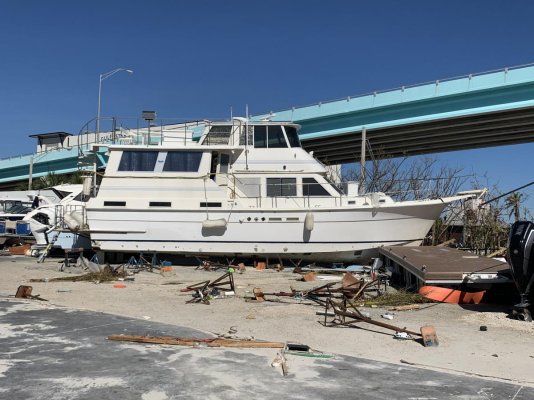Hello Everyone,
Hoping for some input. Our 1985 49’ Gulfstar MY was in the yard getting a bottom job in Fort Myers beach, when Ian hit. We were blown off our stands, and did take on some water. The water damage and bottom seemed minimal initially, but as time went on we have noticed more damage. The boat was being lifted by the crane today, and being placed back on the stands. We can hopefully see what the real damage is now. Here are my 2 main concerns.
1. The water intrusion we found we cleaned up immediately, threw out some area rugs and books. Then found either storm water or rain water seemed to be behind the wall paper, causing it to start to lift and grow mold behind it.
2. Damage to the running gear- We know the wind and waves were hitting the starboard side. What kind of pounding did the running gear take? The positive is it landed on gravel, so there was some give. The starboard rudder looks pushed up about 2-3”s. Would the struts, props, shafts and rudders all need to be replaced? Could that pounding have affected the engines/transmissions?
Just was hoping someone has some thoughts or insight on this.
Thanks for your input,
Paul
Hoping for some input. Our 1985 49’ Gulfstar MY was in the yard getting a bottom job in Fort Myers beach, when Ian hit. We were blown off our stands, and did take on some water. The water damage and bottom seemed minimal initially, but as time went on we have noticed more damage. The boat was being lifted by the crane today, and being placed back on the stands. We can hopefully see what the real damage is now. Here are my 2 main concerns.
1. The water intrusion we found we cleaned up immediately, threw out some area rugs and books. Then found either storm water or rain water seemed to be behind the wall paper, causing it to start to lift and grow mold behind it.
2. Damage to the running gear- We know the wind and waves were hitting the starboard side. What kind of pounding did the running gear take? The positive is it landed on gravel, so there was some give. The starboard rudder looks pushed up about 2-3”s. Would the struts, props, shafts and rudders all need to be replaced? Could that pounding have affected the engines/transmissions?
Just was hoping someone has some thoughts or insight on this.
Thanks for your input,
Paul

